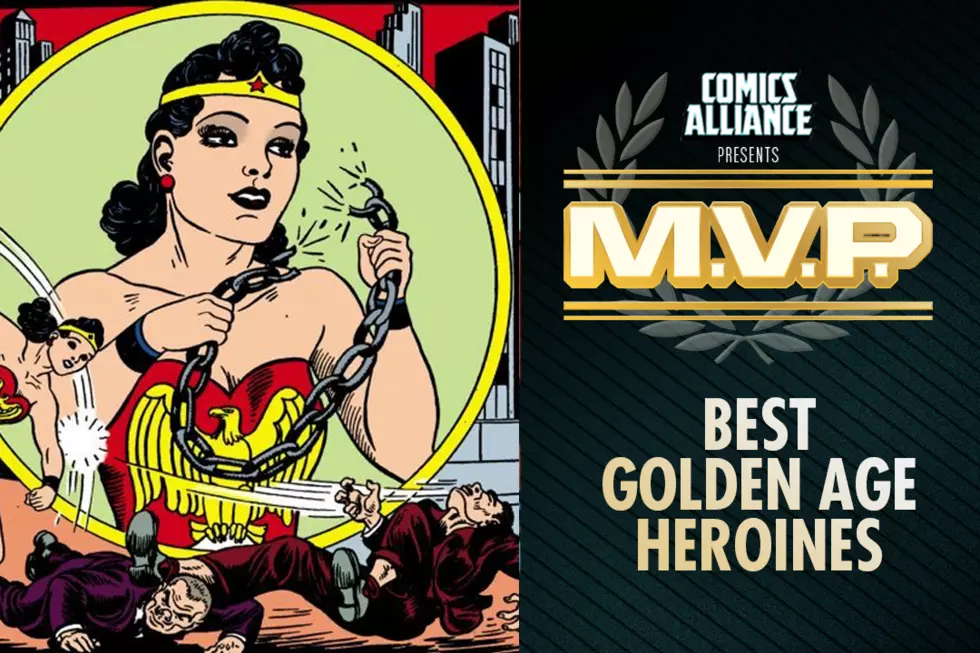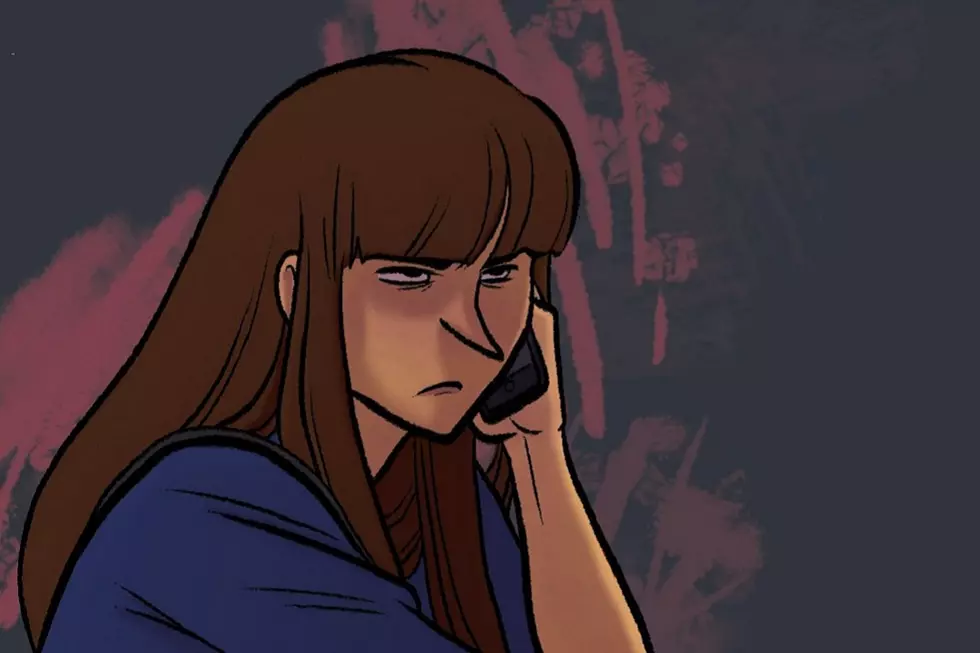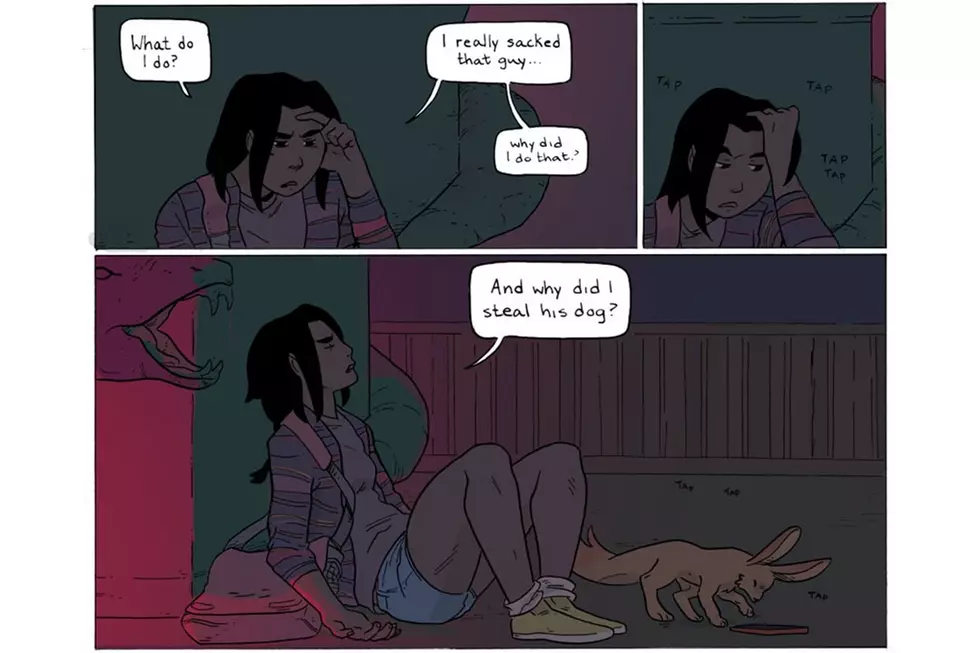
Past Obsession: An Interview With ‘Photobooth: A Biography’ Author Meags Fitzgerald
Last week Meags Fitzgerald's new graphic memoir Photobooth: A Biography debuted and completely blew me away. Fitzgerald is an artist who works in a variety of mediums, including improv, comics, and photobooth photography.
Photobooth, published by Condundrum Press, is not just Fizgerald's love letter to the seemingly dying phenomenon of the chemical photobooth. The author intertwines historical information about the creation and evolution of the photobooth with stories about her interactions with them, and how they changed her life. It's a book about a woman who has come to passionately love something so much that it takes over too much of her life -- an idea that should resonate with many readers.
One fascinating thing about Photobooth is that it's not truly a comic. It's more of a heavily-illustrated non-fiction book. There isn't a lot of narrative from illustration to illustration, especially not in the way that comics readers would expect. The images could not stand alone to tell a story, though the text could technically stand without the illustrations.
That being said, it's a beautiful book where the art provides important visual reference. Many of Fitzgerald's own photobooth photos are recreated in the book, as are many active photobooths she's visited. There's a realism to Fitzgerald's art that at times is closer to photography than illustrations, and these stunningly recreated images help to really immerse the reader in the world of photobooths.
Ultimately, it's that immersion that is the point of the book. It represents both Fitzgerald's personal immersion and her hope that you too will become immersed and care about a form of photography that is not going to be around forever.
As a lover of photography, photobooths, and antiques as well as someone who has consistently struggled with balancing interest and obsession, I decided to speak to Fitzgerald about Photobooth and the intentions behind it.
ComicsAlliance: This project started initially as a much shorter comic you did to basically fund your photobooth exploration. What made you think of doing a comic?
Meags Fitzgerald: I knew I wanted to make comics long before I had the idea for Photobooth: A Biography. I had started a few comic projects over the years that I ultimately stopped when I calculated how long it would take to complete them. This was the first story that I really knew was worth producing.
CA: When did you know you wanted it to become something longer?
MF: I never consciously decided to make a large book -- it’s 280 pages -- I just followed the opportunities to do research and the project took on a life of its own. I could have done more travel and research but I needed to start the writing and drawing phase. I felt a lot of pressure to produce the book in a short period of time because of circumstances in the photobooth industry.
CA: Have comics always been an art form you were interested in? Is it something you’ve studied?
MF: I’ve been a lifelong comic book reader but it’s not something I’ve formally studied. My “education” was pieced together on the fly with advice from my publisher and a few trusted friends in the comics community. I also re-read works by my favourite creators, like Jillian Tamaki and Craig Thompson, and took inspiration from them.
CA: The format itself, while definitely a graphic novel, also verges on being more of an illustrated book, as you don’t use a lot of word balloons and the illustrations are a little less narrative and a little more to support the text. Was this a conscious decision?
MF: My background is in illustration and in storytelling, mostly with improv theatre, so when plotting out the book, I used the narrative devices that felt most natural to me, where my strengths already laid. I knew I couldn’t become an expert cartoonist overnight and I’m not sure the book would have gotten off the ground if I had tried to follow a more conventional format.
CA: The book is partially about the history of photobooths and partially about the history of your love of photobooths. What made you want to merge those two stories?
MF: One of my primary objectives for the book was to make it engaging for readers who didn’t already care about photobooths or photo history. I knew that one of the ways to do that was to tell the story from a personal place and to be honest about my successes and struggles with photobooths. The book is about a lot of things, but at its core it’s about a long term relationship, which most people can relate to.
CA: It seems like most of the people who are seriously passionate about photobooths care primarily about the old-school chemical booths and dismiss the digital booths that have supplanted them. Why do you think digital booths don’t have as many passionate fans?
MF: I think that digital photobooths have a lot of general enthusiasts but essentially no die-hard fanatics. Loving a digital photobooth would be like loving the 2005 film Charlie and the Chocolate Factory. A lot of people saw that movie but it’s probably no one’s favourite movie. Vintage photobooth fans (in this analogy, lovers of the original 1971 Willy Wonka and the Chocolate Factory) have decades of fond memories to fuel their passion.
CA: You talk a lot about how chemical photobooths are near extinction due to a limited supply of paper and one of the chemicals being carcinogenic. Is there the possibility of someone producing the necessary components like the Impossible Project does for Polaroid film? Or researching other chemicals?
MF: Yes, in the last two years a few people have been working on this, but it’s a discreet, hopeful effort. The Impossible Project was a huge undertaking with a big public following. If these alternative papers and chemicals do work out, I doubt users of chemical photobooths would ever be aware of the change. It would likely be more like a back-up option for individuals who own their own photobooths, so that they can keep the machines going after the paper manufacturer finally decides to stop producing it.
CA: Both comics and photobooths sort of occupy a similar place in art in that too often they are not seen as a serious medium by people who don’t really understand them. Do you feel like this is a problem that’s possible to correct? Do you think it’s something we should even bother worrying about?
MF: I believe it’s true that both comics and photobooths live in the fringes of popular culture,but I don’t see that as generally problematic. It is frustrating when you feel misunderstood or under-represented as a small population in a larger society, but there are lots of benefits to being niche too. Comics and photobooths both respectively have tight-knit communities and there’s a lot more freedom in the creative process when you don’t have to please the masses.
CA: A fair number of our readers are also artists - do you have any advice to them regarding art school? Particularly in regards to working in a medium you have a passion for that may not be considered fine art?
MF: My best advice to anyone in art school is to pick your classes based on the instructors you want to learn from and who you feel a connection with. My BFA was an incredibly worthwhile experience, but I don’t think that aspiring artists need to go to art school. However, I do think you need to find a community that you can learn from and that can support you.
CA: You talk a bit in the book about the way photobooths opened up portrait photography to all classes and how, the better the economy was, the worse they did. Do you think that’s part of why there’s a new resurgence of passion for photobooths among collectors now? Is part of the appeal related to preserving something historical in the wake of economic uncertainty?
MF: That’s a great question. I believe it’s true that when the economy is weaker that people turn more introspective and have a tendency to reflect on the past. You may be able to correlate an increased interest in vintage photography to the financial crisis, but it would be difficult to measure. More generally, I think the interest stems from a reaction to the digital era and the careless way we take pictures now. Many people miss the tactility and intimacy of actual photographs.
CA: Your book is obviously heavily researched. Were all the illustrations of the booths in different locations done on the spot, photographed, or did you recreate them from memory?
MF: Long before I knew I would be making a book, I fastidiously documented every photobooth I visited. I also have a fairly reliable photographic memory. So when I started the illustration phase, I had already a sizeable archive of reference imagery and personal memories to draw from. While traveling I did sketch ideas along the way, but those ideas were redrawn and polished up for inclusion in the finished book.
CA: All the booth photos in the book are from your personal collection, correct? Was illustrating them here appealing as a way to share that collection with others?
MF: Yes, I have a collection of over 7,700 photobooth pictures, most of which are of me, and a small percentage are vintage photographs. I used my own photos for reference mainly so that I knew I had the rights to the images. I’d like to say it was about sharing my collection but it was more about not getting sued.
CA: Have you ever been to a comic convention? How do they compare to photobooth conventions?
MF: I’ve been to many comics arts festivals and alternative press expos, but I have never been to a huge dress-up-as-your-favourite-superhero comic book convention -- not yet anyway; I’d like to!
Besides the fact that the photobooth conventions only happen every few years and are fairly small, I’m sure there are similarities. It’s all about celebrating geekdom, meeting your online friends in person and forming connections with like-minded people. At photobooth conventions everyone is taking pictures together. Squeezing into a tight booth and sharing a tiny stool is one way to become fast friends. I imagine it’s a similar experience to when you lock eyes with a stranger dressed as a character complimentary to your own.

CA: Do you have a favorite photobooth model or brand?
MF: Yes! Auto-Photo’s Model 11, it has quintessential 1950s American design and takes the nicest photobooth pictures I’ve seen. It’s the model seen on the front cover of Photobooth: A Biography.
CA: Part of the story is that you found you were taking photobooths so seriously you forgot they were supposed to be fun. I can absolutely relate as that happens with comics for me. Why do you think we do that to ourselves?
MF: I wish I could answer that and then remedy the issue for myself! If, three years ago, you told me that I would be self-employed doing only the creative work that I chose to do, I would have been delighted. But when your passion turns into your career, the boundaries between work and play, professional and personal, all become indistinguishable.
This is something I continue to grapple with. My newest experiment is to have an electronics-free bedroom. I just bought myself an analog alarm clock so that I won’t be tempted to check my emails on my iphone while I’m in bed.
CA: You decided at the end of your journey to readjust your priorities and not spend so much time on photobooths. How has that been?
MF: Haha, well, I’ve been wildly unsuccessful in that pursuit, but that’s okay. There’s only one year left of colour chemical photobooths operating in Canada. In recent months my relationship with photobooths has become quite public, which is great, but over the next year I want to scale the relationship back down, so it’s just about the booths and I; the way it began. During the next year, you won’t ever find me without $4 in my pocket.
CA: Do you plan to do more comics? What’s next for you?
MF: Absolutely! I have ideas for my next two books: a short, poetic, semi auto-biographical comic that I hope to debut at TCAF 2015, and a longer non-fiction graphic novel with a similar structure to Photobooth: A Biography, but on an entirely different subject. I’ve also got some theatre, film and animation projects in the works!
More From ComicsAlliance
![When Everything Is Pink, Nothing Is Pink: Sarah Stern On Color And Creativity [Interview]](http://townsquare.media/site/622/files/2017/03/Cindersong-feat.jpg?w=980&q=75)








